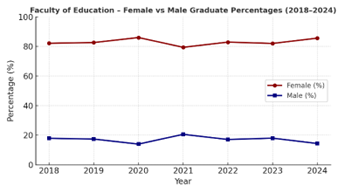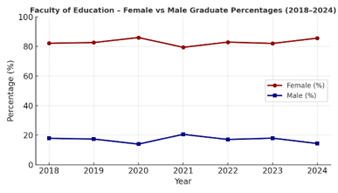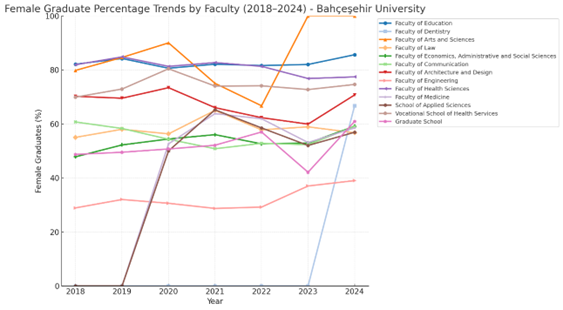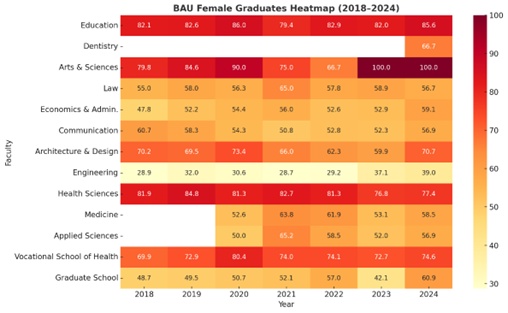Bahçeşehir University (BAU) places a strong emphasis on promoting gender equality through evidence-based practices and continuous data monitoring. One of the key dimensions of this effort is the systematic analysis of graduation data, which enables the university to identify and address potential gender disparities in student outcomes across faculties and years.
Between 2018 and 2024, BAU has collected, analyzed, and visualized comprehensive graduation statistics—disaggregated by gender and faculty—to evaluate patterns in student success. These analyses are represented in detailed table, heatmap and faculty-based trend charts, showing the percentage of female and male graduates over time. This data-centric approach allows BAU to transparently assess progress toward gender balance, highlighting areas of improvement such as the steady increase in female representation within engineering and communication programs.
When gender gaps in graduation rates are detected, BAU implements targeted support mechanisms. These include academic advising, structured mentoring programs, and professional development opportunities designed especially for female students in traditionally male-dominated fields. Such interventions not only enhance academic persistence and achievement but also contribute to a more inclusive and equitable learning environment.
Through continuous tracking of graduation data and gender ratios, Bahçeşehir University demonstrates its commitment to equality in education—ensuring that every student, regardless of gender, is empowered with the resources, support, and opportunities needed to complete their studies successfully and excel in their careers.
Between 2018 and 2024, the Faculty of Engineering at Bahçeşehir University has shown a gradual yet steady increase in the proportion of female graduates, reflecting ongoing institutional efforts to promote women’s participation in STEM disciplines. In 2018, female graduates accounted for approximately 29%, while male graduates represented around 71%. The female share increased slightly to 32% in 2019, before stabilizing near 30% between 2020 and 2022. A significant rise occurred in 2023, when the percentage of female graduates grew to around 37%, followed by a further increase to 39% in 2024.
Conversely, the male graduate proportion decreased from 71% in 2018 to 61% in 2024, reflecting a positive trend toward a more balanced gender distribution. Although male students continue to constitute the majority of engineering graduates, the consistent upward trajectory of female participation underscores Bahçeşehir University’s sustained progress in addressing gender disparities in engineering education.
The graph below visually presents these gender distribution trends within the Faculty of Engineering between 2018 and 2024.

From 2018 to 2024, the Faculty of Economics, Administrative and Social Sciences at Bahçeşehir University has maintained a consistent gender balance, with a gradual increase in female graduates over time. In 2018, female graduates represented approximately 47%, compared to 53% male graduates. The share of female graduates surpassed that of males in 2019, reaching 51%, and continued to rise steadily to 55% in 2020. Female representation peaked at 57–58% between 2020 and 2021, followed by a brief stabilization near 52%–53% during 2022 and 2023.
By 2024, the percentage of female graduates reached 60%, while the male share declined to 40%, marking a notable shift toward female predominance in the faculty’s graduating cohort. This trend indicates the University’s success in fostering equitable participation and promoting women’s advancement within the fields of economics, management, and social sciences.
The graph below visually presents these gender distribution trends within the Faculty of Economics, Administrative and Social Sciences between 2018 and 2024.

Between 2018 and 2024, the Faculty of Health Sciences at Bahçeşehir University has consistently recorded a strong predominance of female graduates, reflecting the University’s commitment to women’s participation in health-related disciplines. In 2018, female graduates accounted for approximately 81% of total graduates, compared with 19% male graduates. This ratio slightly increased to around 84% in 2019, before stabilizing near 80–82% between 2020 and 2022.
In 2023, the share of female graduates remained high at approximately 79%, while male graduates represented 21%. By 2024, the female proportion remained steady at 77–78%, confirming the faculty’s consistent female majority over the seven-year period. This trend highlights Bahçeşehir University’s ongoing success in empowering women within the health sciences and related professions, areas traditionally characterized by strong female representation.
The graph below visually presents these gender distribution trends within the Faculty of Health Sciences between 2018 and 2024.

From 2018 to 2024, Bahçeşehir University’s Graduate School has exhibited an overall trend of balanced gender representation, with a gradual and sustained increase in female graduates over time. In 2018, women constituted approximately 44% of total graduates, while men accounted for 56%. Female representation rose steadily to 47% in 2019 and reached 50% by 2020, achieving gender parity.
Following this milestone, female graduates continued to outnumber male graduates, rising to 53% in 2021 and 55% in 2022. Although a minor decrease was observed in 2023, when the female share slightly declined to 52%, the proportion recovered again in 2024, with women representing 57% of all graduates.
These results underscore Bahçeşehir University’s institutional commitment to advancing gender equality in postgraduate education and promoting inclusive access to research and academic advancement opportunities.
The graph below visually presents these gender distribution trends within the Graduate School between 2018 and 2024.

Between 2018 and 2024, the Faculty of Educational Sciences at Bahçeşehir University has consistently maintained one of the highest female graduate ratios across all faculties. In 2018, women accounted for approximately 83% of total graduates, compared with 17% men. This strong female predominance remained stable in 2019, when the proportion of women slightly increased to 84%, and continued through 2020 at nearly 82%.
In 2021 and 2022, the female share remained consistently high, ranging between 80% and 81%, with only marginal fluctuations. In 2023, female representation rose to around 83%, before reaching 85% in 2024, marking the highest proportion observed during the seven-year period. Male graduates, in turn, represented only 15% of the total by 2024.
This steady gender pattern reflects Bahçeşehir University’s strong tradition in educational sciences, where women continue to play a central role in both academic and professional development within the field of teacher education and pedagogy.
The graph below visually presents these gender distribution trends within the Faculty of Educational Sciences between 2018 and 2024.

From 2018 to 2024, the Faculty of Communication has maintained a female majority with a brief convergence at parity. In 2018, women accounted for 60% of graduates (men 40%). Female representation has edged down to 58% in 2019 and 54% in 2020, reaching parity (50%–50%) in 2021. Since then, the female share has risen again, registering 52% in 2022, 52% in 2023, and 57–58% in 2024 (men 42–43%). Overall, the trend has shown a modest dip around 2020–2021 followed by a recovery, resulting in a clear female predominance by 2024.
The graph below visually presents these gender distribution trends within the Faculty of Communication between 2018 and 2024.

Between 2018 and 2024, Bahçeşehir University has maintained a strong and steadily increasing presence of female graduates across nearly all faculties, reflecting the institution’s long-term commitment to advancing gender equality in higher education. The longitudinal data reveal distinct but converging trends toward balance, with most faculties showing stable or rising female representation.
Faculties such as Education, Dentistry, and Health Sciences consistently recorded the highest shares of female graduates, remaining above 75% throughout the seven-year period. In contrast, Engineering has shown gradual improvement—from below 30% in 2018 to nearly 40% in 2024—demonstrating steady progress in narrowing the gender gap within STEM disciplines. Faculties including Economics, Administrative and Social Sciences, Architecture and Design, and Communication have sustained balanced or slightly female-majority distributions, generally fluctuating between 50% and 65% female representation.
Meanwhile, the Graduate School and School of Applied Sciences have displayed moderate but continuous increases in female graduation rates, reinforcing the university’s holistic inclusion strategy that spans undergraduate to postgraduate education.
Overall, the aggregate trend confirms that women represent a growing proportion of BAU graduates, with notable improvements even in fields traditionally dominated by men. This underscores the University’s institutional success in embedding gender equality across its academic ecosystem.
The graph below visually presents the overall female graduate percentage trends across all faculties of Bahçeşehir University between 2018 and 2024.

The heatmap illustrates the distribution of female graduates across Bahçeşehir University’s faculties between 2018 and 2024, emphasizing the steady dominance of women in most academic areas. Faculties such as Education, Arts and Sciences, and Health Sciences consistently show the highest female representation, exceeding 75–85% throughout the years. Disciplines like Economics, Administrative and Social Sciences, and Communication maintain balanced gender ratios around 50–60%, while Engineering demonstrates gradual improvement—from 29% in 2018 to nearly 39% in 2024—indicating progress in traditionally male-dominated fields.
Overall, the heatmap reaffirms BAU’s continued commitment to fostering gender equality, with strong female participation sustained across nearly all faculties.
The heatmap below visually presents the percentage distribution of female graduates across faculties between 2018 and 2024.

The table provides a comprehensive overview of the total number of female and male graduates across Bahçeşehir University faculties from 2018 to 2024. The data confirm a consistent upward trend in female graduation figures, aligning with the University’s broader progress toward gender equality in higher education.
Throughout the seven-year period, faculties such as Education, Health Sciences, and Arts and Sciences maintained strong female majorities, with women constituting more than two-thirds of total graduates. Faculties including Economics, Administrative and Social Sciences, Communication, and Architecture and Design exhibited near parity, while Engineering recorded the most significant progress, with the number of female graduates rising steadily each year. The Graduate School data further illustrate balanced representation at the postgraduate level, reflecting equal participation opportunities in advanced studies.
Overall, the numerical distribution across years demonstrates a clear and sustained institutional pattern of inclusivity, with gender balance improving across nearly all academic disciplines.
The table below presents the total number of female and male graduates by faculty and year between 2018 and 2024.
